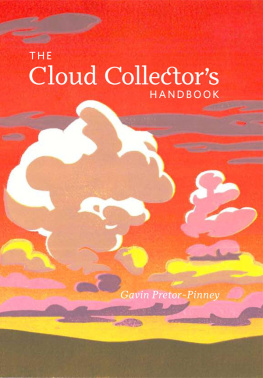You might well think that cloud collecting sounds like a ridiculous idea. How can anyone collect such ephemeral and free-spirited things as clouds? Surely, theyre just about as uncollectable as anything gets.
Magicked into being by the inscrutable laws of the atmosphere, clouds exist in a constant state of flux, shifting effortlessly from one form to another. One moment, theyre joining and spreading into undulating layers. The next, theyre breaking into torn shreds. One moment, theyre building upward in enormous, weighty towers with dark, brooding bases. The next, theyre cascading back down in delicate, translucent streaks. And then theyre goneshedding their moisture as rain or just evaporating into the blue. Theyre like expressions on the face of the sky, and certainly not candidates for a display case. Given all the possible things you might consider collecting, clouds would seem to be a completely silly option.
But thats where youd be wrong. You dont have to own something to collect it. You dont even have to hold it. You just have to notice it and record it.
And that is what this handbook is for. The entries will help you identify a whole range of distinctive cloud types, and some of the amazing optical effects produced by clouds as they scatter the sunlight. Many e-readers enable you to take notes throughout the text. When you spot a particular cloud type, note the details of your sighting - such as date, time, location, and weather conidtions - with the appropriate entry. If your e-reader does not have this functionality, you can share your find at www.cloudappreciationsociety.org. Ideally, keep a camera at hand so that you can back up your claims with photographic evidence.
With each addition to your collection, you earn cloud-collecting points, which are determined by how hard each cloud or effect is to see. While a common old Stratocumulus cloud only earns you 10 points, the fleeting crescent of a horseshoe vortex earns 50 points. The maximum score of 55 belongs to the rare and dramatic breaking waves of the Kelvin-Helmholtz cloudthe jewel of any cloud collection.

Over the Nevada-California border, US, by Bryan Hightower (Member 7929)
Altocumulus lenticularis, ruddy from another long day of being a beautiful cloud.
As your points mount up, they should be counted and re-counted with a greedy cackle. Theyll be essential in judging the worth of your collection, and fueling the bitter rivalry that will develop with fellow cloudspotters.
This handbook is intended to work as a complement to your own photographic records. Of course, you dont have to take pictures, but few cloudspotters can resist. All the photographs here were taken by members of the Cloud Appreciation Society, and can be seen much larger on the societys Web site, along with tips on cloud photography (www.cloudappreciationsociety.org). As the physical manifestation of your cloud collection, such photographic records of meteorological moments serve as something to rifle through and caress back at home.
The system for naming clouds is rather like that for plants and animals, and uses Latin terms to divide them up into different genera, species and varieties. Only the more distinctive and recognizable cloud types are included here. An overview of all the officially recognized classifications . Remember, cloudscapes usually contain a whole range of different cloud types, so dont expect them always to have the orderly, distinct forms of these images.
While it may not have the permanence of a collection of coins, nor the swapability of one of rare stamps, theres something honest about a collection of clouds. Clouds embody the impermanence of the world around us. Nature, wrote Ralph Waldo Emerson, is a mutable cloud which is always and never the same.
Gavin Pretor-Pinney,
The Cloud Appreciation Society
www.cloudappreciationsociety.org/collecting
How Much Is Your Collection Worth?
As you add clouds to your collection, update the totals in pencil from the scorecard on page 5.

Over Mississauga, Ontario, Canada, by Bob Hotte (Member 13770)
A Cumulus congestus tower.

Over Alberta, Canada, by Janice Smith (Member 10496)
Cumulus fractus (as it forms/evaporates).
If youve never spotted a Cumulus cloud, then you ought to get out more. This has to be one of the easiest types to add to your cloud collection (which explains why it earns a low score). Cumulus clouds are the cotton-wool puffs, with flat bases, that drift lazily across the sky on a sunny day. Generally forming a few hours after daybreak, they tend to dissipate before sundown, for they form on thermalsinvisible columns of air rising from the ground as it is warmed by the Sun.
Most forms of Cumulus produce no rain or snow, and so are known as fair-weather clouds. But in .
The little ones, by contrast, are only scary when they take the form of David Hasselhoff.
CUMULUS SPECIES:
- Humilis: wider than it is tall.
- Mediocris: as tall as it is wide.
- Congestus: taller than it is wide.
- Fractus: broken, with ragged edges.
n
CUMULUS VARIETIES:

Over the Isle of Hoy, Scotland, UK, by Eunice Clarke (Member 14190)
Known as fair-weather clouds, Cumulus tend to appear on sunny days.
CLOUD-COLLECTING POINTS
- 15 points: Any Cumulus
- 15 points: Bonus for collecting all four species (see opposite): humilis, mediocris, congestus, fractus
Typical altitudes: 1,0005,000 ft.
Precipitation: none, except for brief showers from Cumulus congestus.
Dont confuse with: .

On a flight from Hanoi to Kuala Lumpur, by Ruziana Mohd Mokhtar (Member 14191)
stratocumulus cities in the sky.
The most widespread of all cloud types, Stratocumulus is a low layer or patch of cloud that has a well-defined, clumpy base. The patches are either joined up or have gaps in between. When the sky is overcast, and the cloud base appears to be low, with tones from white to dark grey, cloudspotters can confidently add Stratocumulus to their cloud collections.
High Stratocumulus that have cloudlets with gaps in betweena variety known as perluciduscan be confused with the midlevel cloud are bigger (appearing larger than the width of three fingers, held at arms length, when they are more than 30 degrees above the horizon).
Due to its sun-blocking tendencies, Stratocumulus may not be the most popular cloud, but it is one of the most varied.
STRATOCUMULUS SPECIES:
- Stratiformis: extends over large areas of sky, rather than forming in patches.
















